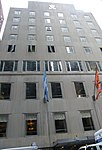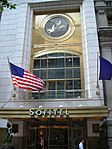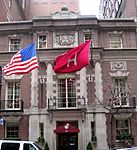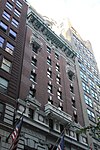The Century Association is a private social, arts, and dining club in New York City, founded in 1847. Its clubhouse is located at 7 West 43rd Street near Fifth Avenue in Midtown Manhattan. It is primarily a club for men and women with distinction in literature or the arts. The Century Association was founded by members of New York's Sketch Club; preceding clubs also included the National Academy of Design, the Bread and Cheese Club, and the Column. Traditionally a men's club, women first became active in club life in the early 1900s; the organization began admitting women as members in 1988.
Named after the first 100 people proposed as members, the first meeting on January 13, 1847, created the club known as the Century; it was incorporated in 1857. It was first housed at 495 Broadway in Lower Manhattan; the club gradually moved uptown, leading to the club's construction of its current location in 1899. During the Civil War, it became headquarters to the U.S. Sanitary Commission. 134 Centurions served in World War I; 110 served in World War II.
The clubhouse, a five-story Palazzo style building, was designed by McKim, Mead & White and built from 1889 to 1891. It became a New York City Landmark in 1967 and was added to the National Register of Historic Places in 1982. It was extensively renovated in the early 1990s, with a fifth floor and terrace constructed in 2009.
Members of the club have included artists and writers William Cullen Bryant, Frederic Church, Asher B. Durand, John La Farge, Winslow Homer, Paul Manship, Augustus Saint-Gaudens, Louis Comfort Tiffany, John Quincy Adams Ward, and J. Alden Weir. Architect members have included Calvert Vaux, Carrère and Hastings, Frederick Law Olmsted, James Renwick Jr., McKim, Mead & White, and York and Sawyer. Members are known for other endeavors, including eight Presidents of the United States, ten US Supreme Court justices, 43 Members of the Cabinet, 29 Nobel Prize laureates, members of the Rockefeller, Vanderbilt, Roosevelt, Jay, Schieffelin and Astor families, and noted individuals like Dan Beard, J. P. Morgan, Samuel Morse, and Anson Phelps Stokes.









